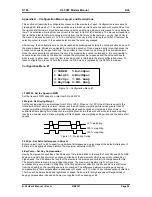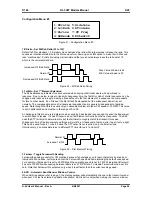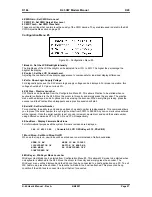
K1EL K45 CW Modem Manual K45
K-45 User’s Manual - Rev A.0
6/6/2021
Page 15
text by paddle, the reserved code di-dah-di-di-dit (
AS
) is used to pause and di-dah-dah-dit-dah
(AK)
is used
to end the session. To look back and review transmitted test, press
INSERT
to pause the session and then
use the
PGDN
and
PGUP
keys to scroll the lines of text. Press
INSERT
again and the display will
automatically go back to where the session left off and practice will resume.
Receive Practice Mode
Figure 7 – Receive Practice Display
Random five letter groups are sent continuously until the user either pauses or ends the session. The
content of the groups is governed by the level set in the Practice Setup Menu. Test progress by hiding Tx
and then copying some number of lines. When done, press
INSERT
,
TAB
, and then
PGDN
to go back and
review what was sent and compare to what was copied. Resume by simply pressing
INSERT
.
Echo Practice Mode
Figure 8 – Echo Practice Display
The K45 sends a list of letters from the selected level and the user must repeat them accurately either by
keyboard or paddle. Each trial starts with a single letter and progresses to a group of five letters by adding
one letter at a time. If the user successfully echoes all five strings, the K45 will send
AR
and then start with a
new group. If the user fails, the K45 will send eight dits and repeat that group until the user gets them all
correct. INSERT, TAB, PGDN and PGUP are very useful here just as they were for Rx practice.
QSO Practice
_QSO_PRACTICE__15WPM
CQ CQ DE K5RF K
K5RF
DE K1EL K
K1EL DE K5
RF UR RST 5NN_
Figure 9 – QSO Practice Display
An interactive QSO experience is presented to the user. The K45 starts off with a CQ which the user
responds to. Exchanges will continue back and forth simulating an actual on air QSO.
All callsigns, names, locations, etc. are purely fictitious and generated at random. The K45 is very
unforgiving when it comes to letter and word spacing. If words or letters are run together, they will be
ignored, and progress will be very slow. The user can choose to use the keyboard or paddles to respond.
When using the keyboard, be sure to put a space after the K, KN, SK, or BK at the end of an exchange. This
will help the K45 will detect the ending quickly. If this is not done, the K45 will still respond but only after a
somewhat long timeout delay.
A full response to the initial CQ is expected
and must include the calling
station’s callsign followed by DE and your callsign. If you don’t get this right the K45 will respond with a
QRZ.
For example, in response to
CQ DE W1XYZ K
, I would reply
W1XYZ DE K1EL K<space>
















































